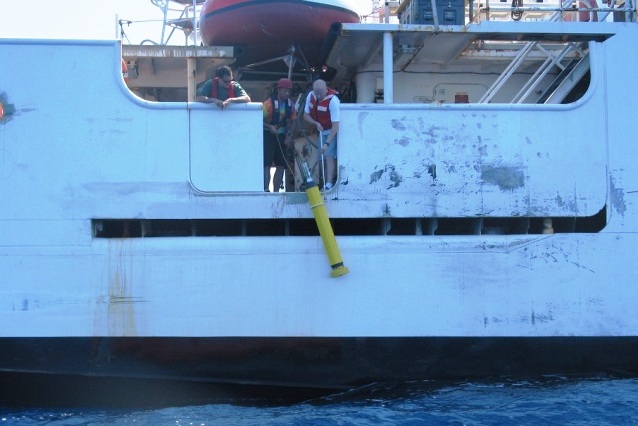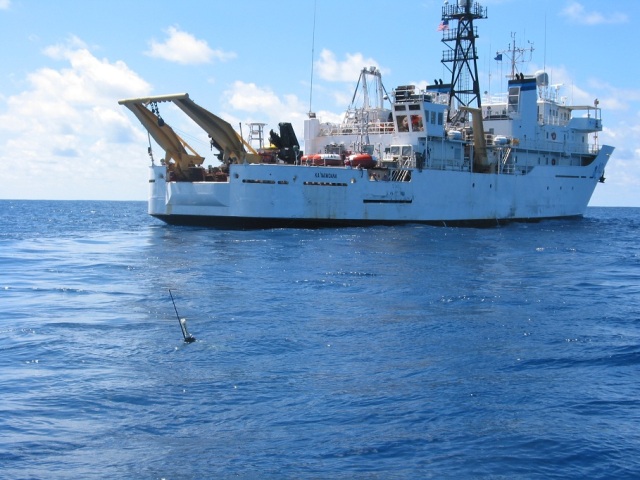
Climate Change Resilience
Thirteen ocean robots are being dropped into the waters over the equator near Kiribati to monitor the ocean there. The latest, high-tech versions of the Argo float, an automatic ocean sensing robot, will help scientists monitor and understand the ocean processes behind El Niño and La Niña events.
The latest generation of Argo floats is upgraded with satellite phones, which allow the data to be transmitted back to shore in minutes, compared with older versions which took hours.

Argo floats are named after the ship that Jason sailed to capture the Golden Fleece in Greek mythology. They collect temperature and salinity data between 2000 metres (6000 feet) depth and the ocean surface and send these data back to land (www.argo.net).
The data are made publicly available in near real-time to be used for oceanographic research, climate research, fisheries research, weather prediction, operational products, and school education.
Started in 2000, the international Argo array consists of more than 3,000 profiling robots in all parts of the world’s ocean, with contributions from at least 32 countries.
“Argo is revolutionizing the way we observe the subsurface oceans. Prior to Argo, the remote regions of the globe could only be sampled every decade or two by research vessels. In contrast, Argo floats are now sampling the global ocean every 10 days” said Dean Roemmich of Scripps Institution of Oceanography, who co-chairs the international team coordinating the 32-nation effort.
It is not easy to keep Argo floats sampling near the equator in the Pacific Ocean because the strong surface currents there quickly move them off the equator. However, it is important that data are fed back from the equatorial Pacific, which is the ocean home of El Niño and La Niña, to predict both the Pacific Islands’ climate and the global climate.
The upgrade means the floats spend less time on the surface, so they can spend more of their four-year life cycle near the equator in the Pacific. Moreover, the new-generation floats are smaller and more energy efficient than earlier models, making them easier to manage and capable of increasing the present four-year lifetime of Argo floats to six years or even longer. The new floats will not only stay near the equator longer, they will collect and transmit more and deeper data than their predecessors providing more detailed knowledge and understanding of interactions between ocean and atmosphere in this globally important area.
 “We expect the new data to give us a better picture of ocean processes, such as mixing in various parts of the water column and how energy moves within the ocean in that part of the world.” said Gregory C. Johnson, Oceanographer at the U.S. National Oceanic and Atmospheric Administration (NOAA) Pacific Marine Environmental Laboratory.
“We expect the new data to give us a better picture of ocean processes, such as mixing in various parts of the water column and how energy moves within the ocean in that part of the world.” said Gregory C. Johnson, Oceanographer at the U.S. National Oceanic and Atmospheric Administration (NOAA) Pacific Marine Environmental Laboratory.
Nine robots have already been deployed by Tonya Watson, a scientific crew member of the NOAA Ship Ka'imimoana, during a recent cruise. These were deployed near Kiribati’s Phoenix Island group and the remaining four will be deployed soon near the Line Island group.
This ship has repeatedly crossed the equatorial Pacific from 165°E (near Nauru) to 95°W (near the Galapagos Islands) since 1996 to service NOAA ocean moorings, and in since 2000 they have also deployed Argo floats, many of which are still collecting vital information on our ocean.
For more information please contact:
Gregory Johnson, NOAA [email protected] and Philip Wiles, SPREP [email protected]
Photographs courtesy of NOAA: ‘An Argo float is deployed in the waters of Kiribati last month by the Research Vessel Ka'imimoana’
The latest generation of Argo floats is upgraded with satellite phones, which allow the data to be transmitted back to shore in minutes, compared with older versions which took hours.

Argo floats are named after the ship that Jason sailed to capture the Golden Fleece in Greek mythology. They collect temperature and salinity data between 2000 metres (6000 feet) depth and the ocean surface and send these data back to land (www.argo.net).
The data are made publicly available in near real-time to be used for oceanographic research, climate research, fisheries research, weather prediction, operational products, and school education.
Started in 2000, the international Argo array consists of more than 3,000 profiling robots in all parts of the world’s ocean, with contributions from at least 32 countries.
“Argo is revolutionizing the way we observe the subsurface oceans. Prior to Argo, the remote regions of the globe could only be sampled every decade or two by research vessels. In contrast, Argo floats are now sampling the global ocean every 10 days” said Dean Roemmich of Scripps Institution of Oceanography, who co-chairs the international team coordinating the 32-nation effort.
It is not easy to keep Argo floats sampling near the equator in the Pacific Ocean because the strong surface currents there quickly move them off the equator. However, it is important that data are fed back from the equatorial Pacific, which is the ocean home of El Niño and La Niña, to predict both the Pacific Islands’ climate and the global climate.
The upgrade means the floats spend less time on the surface, so they can spend more of their four-year life cycle near the equator in the Pacific. Moreover, the new-generation floats are smaller and more energy efficient than earlier models, making them easier to manage and capable of increasing the present four-year lifetime of Argo floats to six years or even longer. The new floats will not only stay near the equator longer, they will collect and transmit more and deeper data than their predecessors providing more detailed knowledge and understanding of interactions between ocean and atmosphere in this globally important area.
 “We expect the new data to give us a better picture of ocean processes, such as mixing in various parts of the water column and how energy moves within the ocean in that part of the world.” said Gregory C. Johnson, Oceanographer at the U.S. National Oceanic and Atmospheric Administration (NOAA) Pacific Marine Environmental Laboratory.
“We expect the new data to give us a better picture of ocean processes, such as mixing in various parts of the water column and how energy moves within the ocean in that part of the world.” said Gregory C. Johnson, Oceanographer at the U.S. National Oceanic and Atmospheric Administration (NOAA) Pacific Marine Environmental Laboratory.Nine robots have already been deployed by Tonya Watson, a scientific crew member of the NOAA Ship Ka'imimoana, during a recent cruise. These were deployed near Kiribati’s Phoenix Island group and the remaining four will be deployed soon near the Line Island group.
This ship has repeatedly crossed the equatorial Pacific from 165°E (near Nauru) to 95°W (near the Galapagos Islands) since 1996 to service NOAA ocean moorings, and in since 2000 they have also deployed Argo floats, many of which are still collecting vital information on our ocean.
For more information please contact:
Gregory Johnson, NOAA [email protected] and Philip Wiles, SPREP [email protected]
Photographs courtesy of NOAA: ‘An Argo float is deployed in the waters of Kiribati last month by the Research Vessel Ka'imimoana’